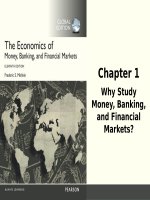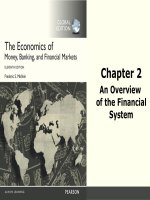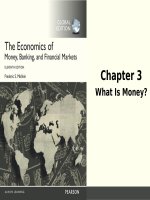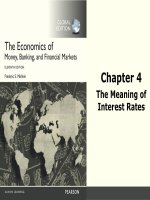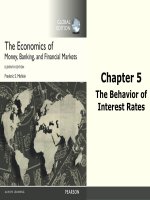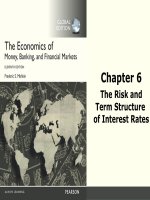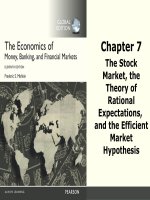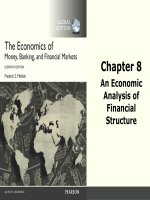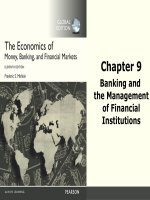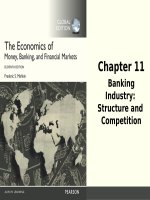The economics of money, banking, and financial institutions 2nd ch15
Bạn đang xem bản rút gọn của tài liệu. Xem và tải ngay bản đầy đủ của tài liệu tại đây (390.47 KB, 22 trang )
Chapter 15
Multiple Deposit
Creation and the
Money Supply
Process
© 2005 Pearson Education Canada Inc.
Four Players
in the Money Supply Process
1. Central bank: the Bank of Canada
2. Banks
3. Depositors
4. Borrowers from banks
Bank of Canada
1. Conducts monetary policy
2. Clears checks
3. Regulates banks
© 2005 Pearson Education
15-2
The Bank’s Balance Sheet
Bank of Canada
Assets
Liabilities
Government securities
Currency in circulation
Advances to banks
Settlement balances
Monetary Base, MB = C + R
© 2005 Pearson Education
15-3
Control of the Monetary Base
MB = C + R
Open Market Purchase from bank
The Banking System
Assets
Liabilities
The Bank of Canada
Assets
Liabilities
Securities – $100
Reserves + $100
Open Market Purchase from Public
Public
Assets
Liabilities
Securities + $100
Reserves + $100
The Bank of Canada
Assets
Liabilities
Securities – $100
Deposits + $100
Banking System
Assets
Securities + $100
Reserves + $100
Liabilities
Reserves
+ $100
Chequable Deposits
+ $100
Result: R ↑ $100, MB ↑ $100
© 2005 Pearson Education
15-4
If Person Cashes Cheque
Public
Assets
Liabilities
Securities – $100
Currency + $100
The Bank of Canada
Assets
Liabilities
Securities + $100
Currency + $100
Result: R unchanged, MB ↑ $100
Effect on MB certain, on R uncertain
The effect of an open market purchase on R depends on whether the seller
of the bonds keeps the proceeds from the sale in deposits or in currency.
The effect of an open market purchase on MB, however, is always the
same whether the seller of the bonds keeps the proceeds from the sale in
deposits or in currency.
© 2005 Pearson Education
15-5
Open Market Sale of Bonds
MB = C + R
Open Market Sale to a bank
The Banking System
Assets
Liabilities
The Bank of Canada
Assets
Liabilities
Securities + $100
Reserves - $100
Open Market Sale to the Public
Public
Assets
Liabilities
Securities - $100
Reserves - $100
The Bank of Canada
Assets
Liabilities
Securities + $100
Deposits - $100
Banking System
Assets
Securities - $100
Reserves - $100
Liabilities
Reserves
- $100
Chequable Deposits
- $100
Result: R ↓ $100, MB ↓ $100
© 2005 Pearson Education
15-6
Open Market Purchase in the
Foreign Exchange (FX) Market
MB = C + R
Open Market Purchase of foreign exchange from a bank
The Banking System
The Bank of Canada
Assets
Liabilities
Assets
Liabilities
FX – $100
FX + $100
Reserves + $100
Open Market Purchase of foreign exchange from the Public
Public
The Bank of Canada
Assets
Liabilities
Assets
Reserves + $100
FX – $100
Deposits + $100
Banking System
Assets
Reserves + $100
Liabilities
Reserves
+ $100
Chequable Deposits
+ $100
FX + $100
Liabilities
Result: R ↑ $100, MB ↑ $100
© 2005 Pearson Education
15-7
If Person Cashes Cheque
Public
Assets
The Bank of Canada
Liabilities
Assets
FX – $100
FX + $100
Currency + $100
Liabilities
Currency + $100
Result: R unchanged, MB ↑ $100
Effect on MB certain, on R uncertain
Again, the effect of an open market purchase on R depends on whether the
seller of FX keeps the proceeds from the sale in deposits or in currency.
The effect of an open market purchase of FX on MB, however, is always
the same whether the seller of the FX keeps the proceeds from the sale in
deposits or in currency.
© 2005 Pearson Education
15-8
Open Market Sale in the FX Market
MB = C + R
Open Market Sale of FX to a bank
The Banking System
Assets
Liabilities
The Bank of Canada
Assets
Liabilities
FX + $100
Reserves -$100
Open Market Sale of FX to the Public
Public
Assets
Liabilities
FX - $100
Reserves - $100
The Bank of Canada
Assets
Liabilities
FX + $100
Deposits - $100
Banking System
Assets
FX - $100
Reserves - $100
Liabilities
Reserves
- $100
Chequable Deposits
- $100
Result: R ↓ $100, MB ↓ $100
© 2005 Pearson Education
15-9
Shifts from Deposits into Currency
Even if the Bank of Canada does not conduct open market operations, a
shift from deposits into currency will affect R. However, such a shift will
have no effect on MB.
Shifts From Deposits into Currency:
Public
Assets
Liabilities
The Bank of Canada
Assets
Liabilities
Deposits – $100
Currency + $100
$100
Currency + $100
Reserves –
Banking System
Assets
Liabilities
Reserves – $100 Deposits – $100
Result: R ↓ $100, MB unchanged
© 2005 Pearson Education
15-10
Advances
Banking System
Assets
Liabilities
Reserves
Advances
+ $100
+ $100
The Bank of Canada
Assets
Liabilities
Advances
Reserves
+ $100
+ $100
Result: R ↑ $100, MB ↑ $100
Conclusion: Bank of Canada has better ability to control MB
than R
© 2005 Pearson Education
15-11
Deposit Creation: Single Bank
Consider a $100 open market purchase from First Bank
First Bank
Liabilities
Assets
Securities
Reserves
– $100
+ $100
First Bank
Liabilities
Assets
Securities
Reserves
Loans
– $100
+ $100
+ $100
© 2005 Pearson Education
Deposits
+ $100
15-12
…
A bank cannot safely make loans for an amount greater
than the excess reserves it has before it makes the loan.
The final T-account of the First Bank (after the reserves
have been withdrawn) is:
First Bank
Assets
Securities
Loans
Liabilities
– $100
+ $100
© 2005 Pearson Education
15-13
Deposit Creation: Banking System (r = 10%)
Bank A
Assets
Reserves
Liabilities
+ $100
Assets
Reserves
Loans
Liabilities
+ $10
+ $90
Deposits
Bank A
+ $100
Deposits
+ $100
Bank B
Assets
Reserves
Liabilities
+ $90
Assets
Reserves
Loans
Liabilities
+$9
+ $81
Deposits
Bank B
+ $90
Deposits
+ $90
© 2005 Pearson Education
15-14
Deposit Creation
© 2005 Pearson Education
15-15
Banking System As a Whole
Assets
Securities
Reserves
Loans
Banking System
Liabilities
– $100
Deposits
+ $100
+ $1000
© 2005 Pearson Education
+ $1000
15-16
Same Result when Banks Invest
their ER in Securities
If the banks choose to invest their ER in securities, the result is
the same. If Bank A buys securities with $90 cheque
Bank A
Assets
Liabilities
Reserves
+ $10
Deposits
+ $100
Securities
+ $90
Seller deposits $90 at Bank B and process is same
Hence, whether a bank chooses to use its ER to make loans or
to buy securities, the effect on deposit expansion is the same.
© 2005 Pearson Education
15-17
Simple Deposit Multiplier
Simple Deposit Multiplier
1
∆D =
× ∆R
r
Deriving the formula
R = RR = r × D
D=
1
∆D =
1
r
r
× R
× ∆R
© 2005 Pearson Education
15-18
Multiple Deposit Contraction
The multiple deposit creation process should also work in reverse.
When the Bank of Canada withdraws reserves from the banking
system , there should be a multiple contraction of deposits.
In fact, the contraction in deposits will be
∆ D = (1/ r ) × ∆ R
Example:
If ∆ R = -100 and (1/ r ) = 10 because r =.10, then
∆ D = -1000.
© 2005 Pearson Education
15-19
Multiple Deposit Contraction: The
Banking System
Assets
Securities
Reserves
Loans
Banking System
Liabilities
+ $100
Deposits
- $100
- $1000
© 2005 Pearson Education
- $1000
15-20
Critique of the Simple Model
Our simple model seems to indicate that the Bank of Canada has
complete control over D. It ignores, however, the fact that deposit
creation stops if:
1. Proceeds from loan are kept in cash (in this case nothing is
deposited in Bank B, and the deposit creation process stops). In this
case ∆ D = 100, not 1000 we calculated earlier.
2. Banks hold more reserves. If Bank A decides to hold on to all
$90 of ER, no deposits would be made to Bank B, and this would
also stop the deposit creation process. Again, in this case ∆ D =
100, not 1000 we calculated earlier.
© 2005 Pearson Education
15-21
Conclusion
The Bank of Canada is not the only player whose behavior
influences D and M.
D and M depend on:
1. the public’s decisions regarding how much C to hold
2. the banks’ decisions regarding the amount of R they
wish to hold, and
3. borrowers’ decisions on how much to borrow from
banks.
© 2005 Pearson Education
15-22
